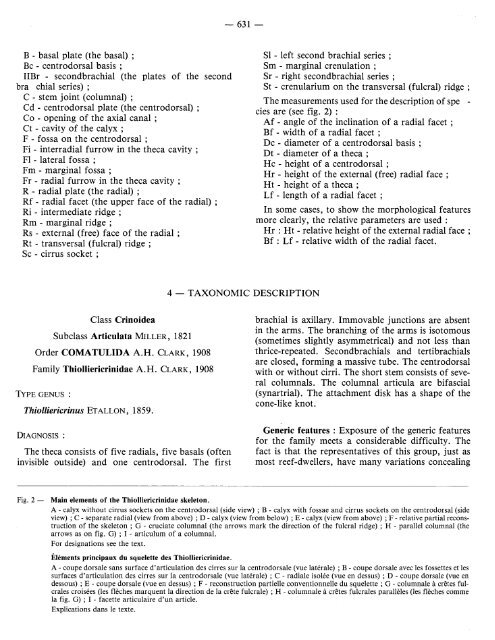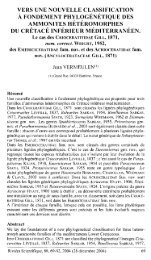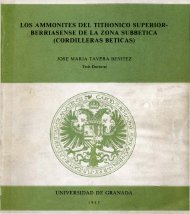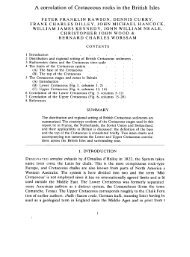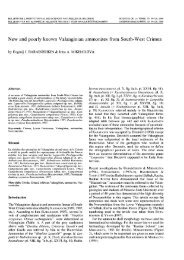— 631 —В - basal plate (<strong>the</strong> basal) ;Be - centrodorsal basis ;IIBr - secondbrachial (<strong>the</strong> plates <strong>of</strong> <strong>the</strong> secondbra chial series) ;С - stem joint (columnal) ;Cd - centrodorsal plate (<strong>the</strong> centrodorsal) ;Co - opening <strong>of</strong> <strong>the</strong> axial canal ;Ct - cavity <strong>of</strong> <strong>the</strong> calyx ;F - fossa on <strong>the</strong> centrodorsal ;Fi - interradial furrow in <strong>the</strong> <strong>the</strong>ca cavity ;FI - lateral fossa ;Fm - marginal fossa ;Fr - radial furrow in <strong>the</strong> <strong>the</strong>ca cavity ;R - radial plate (<strong>the</strong> radial) ;Rf - radial facet (<strong>the</strong> upper face <strong>of</strong> <strong>the</strong> radial) ;Ri - intermediate ridge ;Rm - marginal ridge ;Rs - external (free) face <strong>of</strong> <strong>the</strong> radial ;Rt - transversal (fulcral) ridge ;Sc - cirrus socket ;SI - left second brachial series ;Sm - marginal crenulation ;Sr - right secondbrachial series ;St - crenularium on <strong>the</strong> transversal (fulcral) ridge ;The measurements used for <strong>the</strong> description <strong>of</strong> spe -cies are (see fig. 2) :A f - angle <strong>of</strong> <strong>the</strong> inclination <strong>of</strong> a radial facet ;Bf - width <strong>of</strong> a radial facet ;Dc - diameter <strong>of</strong> a centrodorsal basis ;Dt - diameter <strong>of</strong> a <strong>the</strong>ca ;He - height <strong>of</strong> a centrodorsal ;Hr - height <strong>of</strong> <strong>the</strong> external (free) radial face ;Ht - height <strong>of</strong> a <strong>the</strong>ca ;Lf - length <strong>of</strong> a radial facet ;In some cases, to show <strong>the</strong> morphological featuresmore clearly, <strong>the</strong> relative parameters are used :Hr : H t - relative height <strong>of</strong> <strong>the</strong> external radial face ;Bf : Lf - relative width <strong>of</strong> <strong>the</strong> radial facet.4 — TAXONOMIC DESCRIPTIONClass CrinoideaSubclass Articulata Miller, 1821Order COM ATULIDA A .H . Clark, 1908Family Thiolliericrinidae A .H . Cla r k, 1908Type genus :Thiolliericrinus Et a llo n, 1859.Diagnosis :The <strong>the</strong>ca consists <strong>of</strong> five radiais, five basais (<strong>of</strong>teninvisible outside) and one centrodorsal. The firstbrachial is axillary. Immovable junctions are absentin <strong>the</strong> arms. The branching <strong>of</strong> <strong>the</strong> arms is isotomous(sometimes slightly asymmetrical) and not less thanthrice-repeated. Secondbrachials and tertibrachialsare closed, forming a massive tube. The centrodorsalwith or without cirri. The short stem consists <strong>of</strong> severalcolumnals. The columnal articula are bifascial(synartrial). The attachment disk has a shape <strong>of</strong> <strong>the</strong>cone-like knot.Generic features : Exposure <strong>of</strong> <strong>the</strong> generic featuresfor <strong>the</strong> family meets a considerable difficulty. Thefact is that <strong>the</strong> representatives <strong>of</strong> this group, just asmost reef-dwellers, have many variations concealingFig. 2 —Main elements <strong>of</strong> <strong>the</strong> Thiolliericrinidae skeleton.A - calyx without cirrus sockets on <strong>the</strong> centrodorsal (side view) ; В - calyx with fossae and cirrus sockets on <strong>the</strong> centrodorsal (sideview) ; С - separate radial (view <strong>from</strong> above) ; D - calyx (view <strong>from</strong> below) ; E - calyx (view <strong>from</strong> above) ; F - relative partial reconstruction<strong>of</strong> <strong>the</strong> skeleton ; G - cruciate columnal (<strong>the</strong> arrows mark <strong>the</strong> direction <strong>of</strong> <strong>the</strong> fulcral ridge) ; H - parallel columnal (<strong>the</strong>arrows as on fig. G) ; I - articulum <strong>of</strong> a columnal.For designations see <strong>the</strong> text.Éléments principaux du squelette des Thiolliericrinidae.A - coupe dorsale sans surface d’articulation des cirres sur la centrodorsale (vue latérale) ; В - coupe dorsale avec les fossettes et lessurfaces d’articulation des cirres sur la centrodorsale (vue latérale) ; С - radiale isolée (vue en dessus) ; D - coupe dorsale (vue endessous) ; E - coupe dorsale (vue en dessus) ; F - reconstruction partielle conventionnelle du squelette ; G - columnale à crêtes fulcralescroisées (les flèches marquent la direction de la crête fulcrale) ; H - columnale à crêtes fulcrales parallèles (les flèches commela fig. G) ; I - facette articulaire d’un article.Explications dans le texte.
— 632 —not only specific but also generic limits. However, onecan determine <strong>the</strong> main generic features, being guidedDy phylogenetical considerations (see below), as follows:1 - The degree <strong>of</strong> <strong>the</strong> development <strong>of</strong> cirrus socketson a centrodorsal, namely : a - <strong>the</strong>y are functionaland are distributed regularly (Solonaerium) or irregularly(Thiolliericrinus) ; b - <strong>the</strong>re are no true sockets,but structureless fossae scattered over <strong>the</strong> centrodorsal(Burdigalocrinus) or remained only on <strong>the</strong>suture between radiais and <strong>the</strong> centrodorsal (Umbocrinus,partly Loriolicrinus) ; <strong>the</strong> calyx is deprived <strong>of</strong>any traces <strong>of</strong> cirri (Conoideocrinus, Heberticrinus) ;2 - The degree <strong>of</strong> <strong>the</strong> development <strong>of</strong> radiais,namely : radiais have a high external face and nearlyhorizontal muscular facets (Solonaerium, Burdigalocrinus,Conoideocrinus, Loriolicrinus, partly Thiolliericrinus); radiais are low, <strong>the</strong>ir facets are stronglyinclined outside and bordered close to a centrodorsal(Heberticrinus, Umbocrinus, partly Thiolliericrinus) ;3 - The degree <strong>of</strong> <strong>the</strong> development <strong>of</strong> basais,namely : a - basais are large (Solonaerium, Conoideocrinus,partly Thiolliericrinus and Burdigalocrinus) ;b - basais are small, hardly visible or not visible on <strong>the</strong>external calyx surface (Loriolicrinus, Umbocrinusand Heberticrinus).O<strong>the</strong>r features (size ratio <strong>of</strong> <strong>the</strong> radial ring and <strong>the</strong>centro-dorsal, <strong>the</strong> stem facet construction etc.) arepresent in <strong>the</strong> generic diagnoses given below besides<strong>the</strong> enumerated characteristics. These features, however,have no importance. And what is more, <strong>the</strong>above mentioned generic features, can nei<strong>the</strong>r separately,determine a genus in <strong>the</strong> family Thiolliericrinidae.However, <strong>the</strong>y show quite clearly <strong>the</strong> differencesbetween <strong>the</strong> genera being presented as a table (table2).Intraspecific variation. The form and relative size<strong>of</strong> <strong>the</strong> centrodorsal plate are <strong>the</strong> most variable features<strong>of</strong> Thiolliericrinidae. These variations are markedmainly in cirriless forms. For example Heberticrinusheberti may have <strong>the</strong> centrodorsal height less thanthat <strong>of</strong> <strong>the</strong> radial ring, equal to it or several timesgreater. Besides, <strong>the</strong> place <strong>of</strong> <strong>the</strong> greatest diameter issituated in <strong>the</strong> base <strong>of</strong> <strong>the</strong> low centrodorsal or in <strong>the</strong>upper part <strong>of</strong> high one, directly below <strong>the</strong> radial ring.The centrodorsal diameter can be equal to that <strong>of</strong>radial ring among specimens with an identical size but<strong>the</strong> first diameter can exceed almost two times <strong>the</strong>second one. Heberticrinus heberti has a commonlyround centrodorsal outline. However, specimens withan oval centrodorsal can be found, lenghtening <strong>of</strong>which coincides with a direction <strong>of</strong> <strong>the</strong> fulcral ridgeon its basis. Sometimes <strong>the</strong> rounded-pentangular outlineis marked in large specimens.The stem facet can be greatly deepened on <strong>the</strong> <strong>lower</strong>centrodorsal face <strong>of</strong> H. heberti (this is typical forra<strong>the</strong>r low calyxes), can be flat (in low calyxes) or canproject as an acute ridge (in high calyxes). The centrodorsalbasis is mostly horizontal but it can be placedobliquely with <strong>the</strong> calyx axis. Because <strong>of</strong> this, <strong>the</strong> centrodorsalcan be considerably higher on one side thanon ano<strong>the</strong>r.The radial facets <strong>of</strong> H. heberti more <strong>of</strong>ten adjoindirectly <strong>the</strong> centrodorsal. But in some calyxes, onecan see a narrow strip <strong>of</strong> <strong>the</strong> free radial surface dividing<strong>the</strong> facet <strong>from</strong> <strong>the</strong> centrodorsal. The width <strong>of</strong>this strip can varied, though in a small degree, even ondifferent sides <strong>of</strong> <strong>the</strong> same specimen.The size <strong>of</strong> basal plates is also subjected to a variation.Being concealed under <strong>the</strong> radiais, <strong>the</strong>y neverhave an equal length. Some basais, even in one calyx,hardly reach a half <strong>of</strong> <strong>the</strong> distance <strong>from</strong> <strong>the</strong> centre to<strong>the</strong> outer edge while <strong>the</strong> o<strong>the</strong>rs can appear upon <strong>the</strong>external calyx surface. These variations are marked inHeberticrinus heberti and Burdigalocrinus maximus.The basais <strong>of</strong> Umbocrinus umbonatus are quite visible,as a rule, on <strong>the</strong> calyx surface. However, <strong>the</strong> caseswere marked, when some basais <strong>of</strong> individual specimensare concealed under <strong>the</strong> radiais.The sculpture <strong>of</strong> <strong>the</strong> external calyx surface is <strong>the</strong>relatively insignificantly variable feature. For example,<strong>the</strong> calyxes <strong>of</strong> Thiolliericrinus belbekensis arecovered with small granules and <strong>the</strong> radiais <strong>of</strong> T. torosusbear big knobs. However, a weak sculpture in <strong>the</strong>form <strong>of</strong> small irregular granules is observed in somespecimens <strong>of</strong> Umbocrinus umbonatus, for which <strong>the</strong>smooth calyxes are typical.One must emphasize <strong>the</strong> difference between <strong>the</strong>intraspecific and <strong>the</strong> intrapopulational variations.The specimens which belong to <strong>the</strong> same species arerelatively poorly differ in each <strong>of</strong> <strong>the</strong> local population.At <strong>the</strong> same time, one can hardly found <strong>the</strong>forms which would be united under <strong>the</strong> same specificname even <strong>the</strong> two bioherms are placed side by side.Seven genera : Solonaerium Éta llo n, 1862 emend.Rasm ussen, 1978, Thiolliericrinus Éta llo n, 1859,Burdigalocrinus Jaekel, 1918, Loriolicrinus Jaekel,1918, Conoideocrinus nov. gen., Heberticrinus nov.


